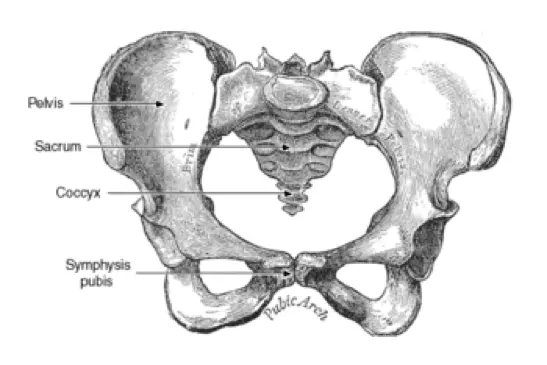Pain at the pubic bone is also known as pelvic girdle pain
It is a common ailment experienced during pregnancy
In fact, in a study by Mogren (2006), 50% of pregnant women have some type of pelvic girdle pain prior to 20 weeks gestation. The pain can make daily activities like working, walking, and doing chores, painful if not impossible, and can can also negatively affect quality of life and sexual life during pregnancy (Mogren, 2006).
Symptoms of Pelvic Girdle Pain (Pubic Symphysis Pain):
- Mild to severe pain over the pubic symphysis
- Pain can extend down the groin and inner thighs (one or both sides)
- Pain can be felt at the sacroiliac (SI) joints, glutes or thighs
- Pain with standing (especially on one leg)
- Pain with prolonged sitting
- Pain with movements like sit to a stand, rolling over in bed, or going up or down stairs
- Clicking in the joint present
What to do if you have pelvic girdle pain:
Contact a pelvic floor therapist
Oftentimes, those with pelvic girdle pain may require advanced manual techniques to restore normal alignment, reduce muscle spasm, and perform stabilization exercises that will strengthen the area without causing further pain. Getting a referral for an evaluation from a pelvic floor therapist will help guide you get the care you need and the guidance you'll need through this process.
Modify Activities
Avoid positions that make your pain worse. If certain activities cause pain, for example, standing on one leg while slipping a shoe strap over your heel, sit down instead.
Keep legs together when rolling over in bed or getting out of the car, imagine you are wearing a tight mini-skirt. Try getting into bed "on all fours" and then lying on your side, rather than sitting in bed and lifting her legs up. Avoid positions with legs separated very wide: deep squat, child’s pose, butterfly stretch.
Pillow between the legs when you sleep on your side at night. Gently squeeze the pillow when you roll in bed.
Pelvic Brace
Stabilize your core with a pelvic brace when you lift objects and go up/down the stairs. To perform a pelvic brace: gently contract the pelvic floor (kegel) while activating your transverse abdominis muscles (“belly to spine”).

Wear a support belt
Get a compression belt or maternity support to help stabilize your pelvis. We like the Serola belt and sell them at Femina PT. Wear the belt when up and about, especially with exercise and household chores.
Gentle Exercise
Cut out high impact exercise when experiencing pain. Instead, try walking, swimming, and gentle yoga.
For more information on pubic symphysis pain read this article by Heather Jeffcoat.
Would you like more support?
Contact Femina PT for an appointment today!

